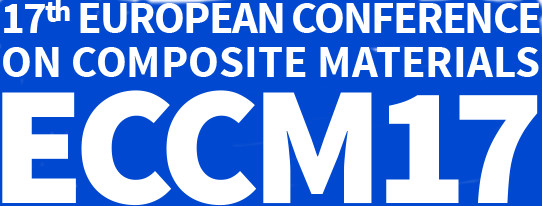

App-Einstellungen:
STATISTICAL LIFE TIME PREDICTION FOR UNIDIRECTIONAL CARBON FIBER REINFORCED THERMOPLASTICS UNDER CREEP LOADING
Yoko Morisawa (Kanazawa Institute of Technology) Masayuki Nakada (Kanazawa Institute of Technology) Yasushi Miyano (Kanazawa Institute of Technology)
The statistical creep failure time under tension loading for unidirectional CFRTP is predicted based on the viscoelastic behavior of matrix. The validity of predicted results is cleared by comparing with the experimental results.
THE IMPACT OF ENVIRONMENTAL STRESS ON THE MECHANICAL BEHAVIOR OF FIBER-METAL-LAMINATES WITH ELASTOMER INTERLAYERS (FMEL)
Matthias Stoll (Karlsruhe Institute of Technology) Kay Weidenmann (Karlsruhe Institute of Technology)
CFRP-Aluminum-Laminates with an elastomer interlayer are potentially damaged when subject to thermal cycling. Flexural properties were used to determine the residual properties and evaluate the influence of thermal cycling on the laminate.
NON-DAMAGING AND SCALEABLE CARBON NANOTUBE SYNTHESIS ON CARBON FIBRES
Hugo De Luca (Imperial College London) David Anthony (Imperial College London) Hui Qian (Imperial College London) Emile Greenhalgh (Imperial College London) Alexander Bismarck (University of Vienna) Milo Shaffer (Imperial College London)
The continuous production of carbon nanotube-grafted-carbon fibres is demonstrated in an open chemical vapour deposition reactor, whilst maintaining the underlying original carbon fibres mechanical properties.
ANALYSIS OF PARAMETRIC INFLUENCE ON MACHINING IN DRY DRILLING CARBON FIBER REINFORCED EPOXY COMPOSITES
Mohamed Faycal Ameur (Ecole Nationale Superieure de Technologie) Malek Habek (Université de Picardie Jules) Mohamed Kenane (Laboratoire des Sciences et Génie des Matériaux (Faculté de Génie Mécanique et Génie des Procédés USTHB) Hamdi Aouici (Ecole Nationale Supérieure de Technologie) Mohamed Cheikh (Université de Toulouse)
DESIGN OPTIMIZATION OF CFRP RECTANGULAR BOX SUBJECTED TO ARBITRARY LOADINGS
Qitao Guo (University of Tokyo) Zaoyang Li (University of Tokyo) Toshiro Ohori (University of Tokyo) Jun Takahashi (University of Tokyo)
A rectangular box subjected to flexural and torsional loadings was optimized by using multi-material solution and thickness optimization. Weight reduction of 64.55% and 29.43% by CFRP can be achieved considering the flexural and torsional rigidity.
FLEXURAL EXPERIMENTAL ANALYSIS COUPLED TO AN ACOUSTIC EMISSION STUDY OF A CURVED SANDWICH STRUCTURES MADE BY FILAMENT WINDING PROCESS
Mohamed Haddad (Arts et Metiers ParisTech) Laurent Guillaumat (Ecole Nationale Supérieur d'Arts et Metiers)
This study examines the quasi-static mechanical behavior of curved sandwiches, made by filament winding process of glass-fiber/vinylester composite skins with different types of foams, focusing on flexural deformation coupled to Acoustic Emission.
INSTRUMENTED SPHERICAL INDENTATION BEHAVIOR OF MECHANICAL PROPERTIES OF METALLIC FOAMS: CHARACTERIZATION
Ali Nayebi (Shiraz University) A. Surmiri (Shiraz University)
Spherical indentation of metallic foams is simulated by FEM and the load - displacement is obtained. The stress–strain curves and the Elastic modulus of different metallic foams are characterized by the new proposed relations of the indentation test.
NUMERICAL EXPERIMENTAL STUDY ON INFLUENCE OF MULTIWALLED CARBON NANOTUBE ON INTERFACE FRACTURE OF SANDWICH COMPOSITE
Alak Kumar Patra (Indian Institute of Technology Kharagpur) Nilanjan Mitra (Indian Institute of Technology Kharagpur)
Finite element analysis (FEA) is followed by experiment on interface fracture toughness (GIC) of sandwich composite with and without MWCNT. MWCNT improved GIC by cost effective methodology. FEA results agree with experiment, HRTEM and FESEM analyses.
SCALING EFFECTS IN THE COMPRESSION BEHAVIOR OF SANDWICH STRUCTURES WITH CORRUGATED COMPOSITE CORES
Jin Zhou (University of Liverpool) Z. Guan (University of Liverpool) Rehan Umer (Khalifa University) S. Balawi (Khalifa University) Wesley Cantwell (Khalifa University)
This project considers the mechanical properties and scaling effects in the compression behavior of sandwich structures manufactured using glass fibre/epoxy and carbon fibre/epoxy curvilinear composite cores.
THE EFFECT OF SURFACE FINISHING OPTIONS FOR CORE MATERIALS ON MECHANICAL PROPERTIES OF SANDWICH STRUCTURES
Cihan Kaboglu (Imperial College London) Soraia Pimenta (Imperial College London) Andy Morris (EDF Energy) John P. Dear (Imperial College London)
This work studies the effect of surface finishing options for core materials on the mechanical properties of sandwich structures. It is shown that surface finishing options increase the shear strength of these structures.
